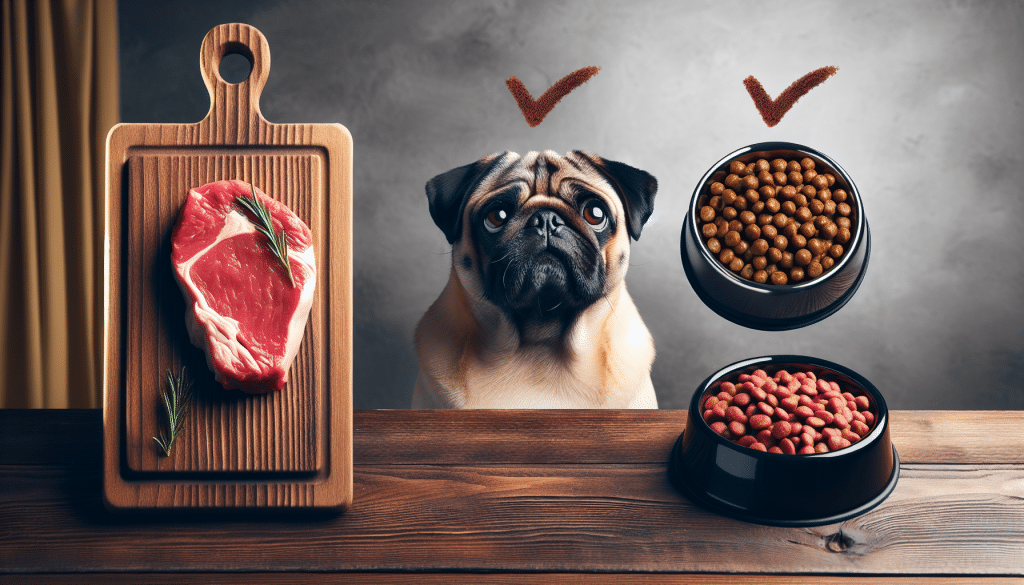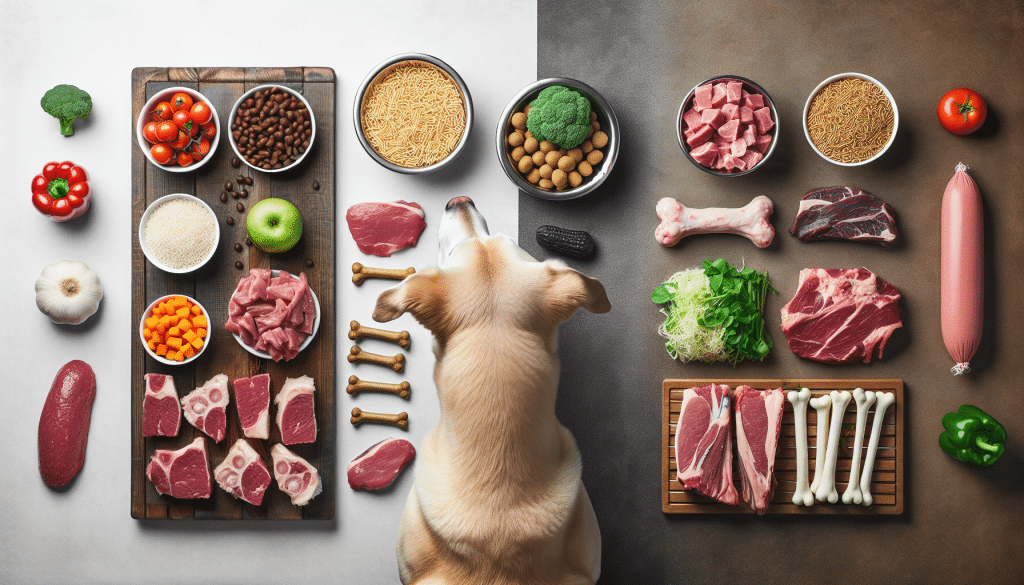If you're a dog owner, you've probably wondered whether raw or cooked food is the better choice for your furry friend. In this article, we'll break down the benefits and drawbacks of both raw and cooked dog food options, helping you make an informed decision for your canine companion. Whether you're looking to improve their overall health, address specific dietary needs, or simply provide them with the tastiest meals, we'll explore the factors to consider when choosing between raw and cooked dog food. So, let's dig in and find out which option is the best fit for your four-legged family member!

This image is property of images.unsplash.com.
Raw Dog Food
Definition of raw dog food
Raw dog food refers to a diet that consists of uncooked, unprocessed, and fresh ingredients. It typically includes raw meats, bones, organs, fruits, and vegetables. This type of diet aims to mimic the natural diet of dogs' ancestors, who consumed raw, prey-based meals in the wild.
Benefits of raw dog food
Raw dog food offers various benefits to your furry friend's overall health and well-being. Firstly, it provides a biologically appropriate and nutrient-dense diet, which can enhance their energy levels, coat condition, and muscle development. Secondly, raw dog food often contains higher moisture content, which aids in hydration and urinary tract health. Additionally, supporters of raw feeding claim that it can improve digestion, reduce allergies, promote a healthier immune system, and minimize the risk of certain health conditions, such as obesity and dental problems.
Potential risks of raw dog food
While raw dog food can offer numerous benefits, it is crucial to understand the potential risks associated with it. One primary concern is the possibility of bacterial contamination, such as Salmonella or E. coli. This risk extends not only to your dog but also to other family members who may come into contact with the raw food. It is essential to handle and prepare raw dog food safely to minimize this risk. Another consideration is the nutritional imbalance that may occur if the diet is not properly formulated or if essential nutrients are lacking. Working closely with a veterinarian or a trained canine nutritionist can help mitigate these risks and ensure that your dog receives a well-rounded diet.
Types of raw dog food
There are several options when it comes to feeding your dog a raw diet. The most common types include:
-
Commercial Raw Diets: These are pre-packaged raw dog food formulations available in pet stores or through specialized online retailers. They usually consist of a balanced mix of raw meats, bones, organs, and vegetables.
-
Homemade Raw Diets: Some dog owners prefer to prepare raw dog food themselves, providing complete control over the ingredients and their dog's diet. However, it is crucial to research and consult with a professional to ensure the diet is nutritionally balanced.
-
Prey Model Diet: This approach adheres closely to the diet of dogs' wild ancestors, focusing on feeding whole prey animals or a combination of muscle meat, bones, and organs. Implementing the prey model diet requires careful planning to achieve nutritional balance.
Cooked Dog Food
Definition of cooked dog food
Cooked dog food refers to a diet that involves the cooking of ingredients before feeding them to your dog. This type of diet typically includes cooked meats, grains, vegetables, and sometimes vitamins and supplements. Cooking the ingredients can help improve their digestibility and enhance the flavor.
Advantages of cooked dog food
Cooked dog food offers certain advantages that may appeal to dog owners. Firstly, cooking the ingredients eliminates the risk of bacterial contamination, making it a safer option for both the dog and the household. It may also be easier for some dogs to digest cooked food, especially if they have a sensitive stomach or underlying gastrointestinal issues. Additionally, cooking the food can enhance its taste and aroma, potentially encouraging picky eaters to consume their meals more enthusiastically. Moreover, commercially prepared cooked dog food often comes in a wide range of flavors and formulations, catering to specific dietary needs and preferences.
Possible disadvantages of cooked dog food
While cooked dog food has its benefits, there are also some potential downsides to consider. One major concern is the possible loss of certain nutrients during the cooking process, such as heat-sensitive vitamins and enzymes. To address this issue, some cooked diets may require supplementation to ensure adequate nutrient intake. Another consideration is that cooked dog food generally has a lower moisture content compared to raw food, which may lead to decreased hydration levels if not compensated for with additional water consumption. Lastly, certain cooking methods, such as frying, can add unnecessary fats and oils to the diet, potentially affecting weight management.
Types of cooked dog food
Cooked dog food is available in various forms to suit different preferences and dietary needs:
-
Commercially Prepared Cooked Diets: These pre-packaged cooked dog food formulations offer convenience and are typically balanced diets designed to provide essential nutrients.
-
Home-Cooked Meals: Some dog owners prefer to prepare cooked meals for their pets using fresh ingredients. This approach allows for customization and control over the ingredients and cooking methods.
-
Prescription Cooked Diets: These specialized diets are often prescribed by veterinarians to address specific health conditions or dietary restrictions.

This image is property of images.unsplash.com.
Nutritional Considerations
Protein content
Protein is an essential component of a dog's diet and plays a crucial role in maintaining muscle mass, supporting the immune system, and promoting overall growth and repair. Both raw and cooked dog food can provide an adequate amount of protein, depending on the ingredients used. However, it is important to ensure that the protein sources are of high quality and contain a complete amino acid profile.
Vitamins and minerals
Dogs require a wide range of vitamins and minerals for optimal health. Raw and cooked dog food can both offer these essential nutrients, but the cooking process may affect the bioavailability of certain vitamins. To compensate for potential nutrient losses, it may be necessary to supplement a cooked diet with additional vitamins and minerals.
Digestibility
The digestibility of a dog's food affects how effectively their body is able to extract and absorb nutrients. Raw dog food is often touted for its high digestibility due to its natural state and minimal processing. However, cooked dog food can also be highly digestible if the ingredients are properly cooked and prepared. Monitoring your dog's stool quality and overall gastrointestinal health can help determine the digestibility of their chosen diet.
Contamination risks
One of the concerns surrounding raw dog food is the potential risk of bacterial contamination, as mentioned earlier. To minimize the contamination risks, it is crucial to handle raw ingredients safely, practice proper hygiene, and ensure that the food is sourced from reputable suppliers. Cooked dog food generally has a lower risk of bacterial contamination, but proper food storage and handling practices should still be followed.
Digestive Health
Effects on gastrointestinal system
Both raw and cooked dog food can have varying effects on a dog's gastrointestinal system. Raw food enthusiasts often claim that feeding a raw diet can improve digestion, reduce bloating, and alleviate certain digestive issues in dogs. However, some dogs may experience digestive upset when transitioning to raw food, especially if the introduction is too sudden or if the new diet does not suit their individual needs. Cooked dog food, on the other hand, may be easier for some dogs to digest, particularly those with sensitive stomachs or a history of gastrointestinal problems.
Prevention of digestive issues
A balanced and well-formulated diet, whether raw or cooked, can contribute to maintaining a healthy digestive system in dogs. It is essential to monitor your dog's stool consistency, frequency, and overall well-being to ensure their gastrointestinal health. Gradual transitions between diets, proper portion control, and regular veterinary check-ups can help identify and address any digestive issues that may arise.

This image is property of images.unsplash.com.
Dental Health
Impact on dental hygiene
Dental health is crucial for a dog's overall well-being, and diet can play a role in maintaining oral hygiene. Many raw dog food supporters claim that feeding raw bones and natural chews can help promote dental health by reducing plaque and tartar buildup. The chewing and tearing action required to consume raw meat and bones can also help exercise the jaw muscles and prevent dental diseases. Cooked dog food, while not directly providing dental benefits like raw bones, can still be a part of a dental hygiene routine if paired with appropriate dental care practices.
Prevention of dental problems
In addition to feeding a suitable diet, it is important to implement other dental care practices to prevent dental problems in dogs. Regular brushing of their teeth using dog-friendly toothpaste and chew toys specifically designed for dental health can help promote gum health and maintain clean teeth. Professional dental cleanings performed by a veterinarian may also be necessary as part of a comprehensive dental care regimen.
Weight Management
Effect on weight
Maintaining a healthy weight is crucial for a dog's overall health, as obesity can lead to various health problems. Both raw and cooked dog food can contribute to weight management, but it ultimately depends on the specific diet and portion sizes. Raw feeding enthusiasts often argue that a natural, prey-model diet helps dogs maintain a healthy weight by providing nutrient-dense, whole foods in their biologically appropriate form. Cooked dog food, when portioned and formulated properly, can also support healthy weight management.
Control and prevention of obesity
To effectively control and prevent obesity in dogs, it is important to consider their individual caloric needs, energy levels, and overall health. Regular exercise, portion control, and feeding appropriate quantities of a nutritionally balanced diet are key factors in weight management. Monitoring body condition scores and consulting with a veterinarian can help ensure that your dog maintains an optimal weight throughout their life.

Food Allergies and Sensitivities
Recognition of allergies and sensitivities
Some dogs may experience allergies or sensitivities to certain ingredients in their food, causing adverse reactions. Common allergens for dogs include grains, specific proteins, and certain additives. Recognizing the signs of food allergies or sensitivities, such as itching, gastrointestinal upset, or recurrent ear infections, is crucial in determining the best diet for your dog.
Management of food-related allergies
Both raw and cooked dog food can be used to manage food allergies or sensitivities, depending on the specific allergens involved. Raw feeding enthusiasts often claim that feeding a raw diet, free from common allergens and additives, can alleviate allergy symptoms. Cooked dog food, particularly hypoallergenic formulations or those recommended by veterinarians, can also be helpful in managing food-related allergies. Identifying the specific allergens through elimination diets or allergy testing is essential in formulating an appropriate diet for your dog.
Cost Analysis
Comparison of costs
The cost of feeding raw or cooked dog food can vary depending on several factors, including the chosen diet type, sourcing of ingredients, and the size and dietary needs of your dog. Raw dog food can be more expensive due to the quality of ingredients, potential need for specialized supplements, and the additional time and effort required for preparation. On the other hand, commercially prepared cooked dog food may have a higher price tag due to processing and packaging costs. Homemade cooked dog food can offer some cost savings, but it requires careful research and formulation to ensure nutritional balance.
Factors influencing expenses
Several factors can influence the expenses associated with feeding raw or cooked dog food. These factors include the quality and sourcing of ingredients (organic, human-grade, etc.), the need for additional supplements or veterinary consultations, and the size or breed-specific dietary requirements of your dog. It is important to consider these factors and budget accordingly to provide a healthy and balanced diet for your canine companion.

Choosing the Right Option
Considerations for deciding on raw or cooked food
When deciding between raw and cooked dog food, several considerations should be taken into account. These considerations include your dog's specific nutritional needs, health conditions, and any dietary restrictions. Your dog's taste preferences, feeding routine, and your own lifestyle and preferences should also be considered. Consulting with a veterinarian or a trained canine nutritionist can provide valuable guidance in choosing the most suitable diet for your furry friend.
Consulting with a veterinarian
Before making any significant changes to your dog's diet, it is essential to consult with a veterinarian. They can assess your dog's overall health, provide guidance on choosing the right type of food, and offer suggestions on how to transition between diets safely. A veterinarian can also assist in formulating a well-balanced diet specific to your dog's needs while addressing any potential health concerns or dietary restrictions.
Transitioning between Diets
Step-by-step transition process
Transitioning between diets should be done gradually to minimize the risk of digestive upset or food aversion. To transition from one diet to another, start by replacing a small portion of the current diet with the new food. Over the course of a week or two, gradually increase the amount of new food while reducing the old food. This slow process allows your dog's digestive system to adjust to the new diet and minimizes the chances of gastrointestinal issues.
Monitoring and adjusting during transition
During the transition period, it is important to monitor your dog's overall health, appetite, stool quality, and any signs of discomfort or distress. If any issues arise, such as persistent digestive upset or refusal to eat, it may be necessary to slow down the transition process or consult with a veterinarian. Adjustments to portion sizes and feeding schedules may also be necessary as your dog's dietary needs can change over time.
In conclusion, the choice between raw and cooked dog food ultimately depends on factors such as your dog's specific needs, health conditions, and your own preferences. Both options have their pros and cons, and it is important to consider the nutritional considerations, digestive health, dental health, weight management, food allergies and sensitivities, cost analysis, and consult with a veterinarian before making a decision. Transitioning between diets should be done gradually, with close monitoring and adjustments as necessary. By giving careful thought to these factors and providing a balanced and appropriate diet, you can help ensure the overall health and well-being of your beloved canine companion.



2 comments
[…] Have you ever come home to find your favorite pair of shoes completely annihilated by your beloved furry friend? If the answer is yes, then you understand the frustration of dealing with a dog who just can’t seem to resist sinking their teeth into everything they lay their eyes on. But fear not! In this article, we will explore some tried and tested training methods that can effectively reduce excessive chewing in dogs. With a little patience and consistency, you’ll soon be able to enjoy a chew-free home and keep your precious belongings intact. Say goodbye to chewed-up shoes and hello to a well-behaved canine companion! […]
[…] associated with allergies. Food elimination trials involve systematically removing certain foods from a dog's diet to identify potential food […]
Comments are closed.